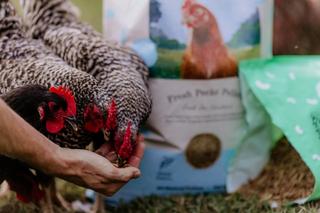Bedding for Your Chickens


Are you using the right materials?
There is a great deal of misinformation out there regarding bedding for small flocks. First of all, let’s define litter vs. bedding, as the terms can sometimes be used interchangeably. What’s the difference? Bedding is the material that is spread on the floor of the coop, mainly on the inside part of the coop. Litter is bedding mixed with the manure produced by your flock. So that means you may put in fresh, clean bedding at the beginning of the month, but at the end of the month, if you have not been removing manure daily, you will be cleaning out litter.
Types of bedding
Nowadays, you have many options when it comes to choosing a litter material for your small flock. There is a lot of conversation on webpages, blogs, and forums about the types of bedding to use. Some people stick with wood shavings, while others are more adventurous. See the chart below for the pros and cons of each type of bedding.
There are many factors that will influence your choice of bedding. Of all the research that has taken place on different types of litter, cost tends to be the main factor. Next in importance is particle size. Bedding that is large tends to poke the feet or breast which can lead to bumblefoot or breast lesions, so it's best to use a bedding of small size.
When speaking of bedding in this article, we are mainly focused on what goes inside the coop on the floor, rather than in the nest boxes or outside in the run. If sand is being considered, then I prefer the use of sand in the run rather than the interior of the coop.
The jury is still out on the issue of dangerous fumes from cedar shavings. Both softwood and hardwood shavings off-gas (or release gases) when they are taken out of their packaging. There is no research indicating that these are particularly harmful to the specialized respiratory system of chickens, regardless of their age. Most of the research was done in rodents in laboratory settings.
If you are worried about off-gassing in wood shavings, then un-bale them and let them sit in a plastic bin for a week before putting them in with your chickens. This will aid in reducing the amount of initial off-gassing your flock is exposed to when they are finally put in the coop.
Other wood products (like paper, cardboard, bark, or recycled wood pallets) are fine to use and results in good growth by chickens. However, smaller particle size is better, and you may need to run a large magnet through the recycled wood pallet material to check for residual metal. Chickens like to search for interesting things in their litter, and they don't hesitate eating the things that they find, including metal.
Type of Bedding Pros Cons Softwood shavings (Pine, Aspen) Readily available, inexpensive, soft and absorbent, compostable Can be dusty, cakes when wet, less off-gassing Sand Easy to clean, drains well when graded, can be the regional soil type of the run, reduced dust, can keep coop cooler in the summer VERY HEAVY and only gets heavier each year, cold (no insulation if the layer is less than 4.5˝), avoid dusty types of sand (like sandbox sand), not compostable, Doesn't provide a soft surface for hard landings, can be an expensive investment initially Hardwood shavings (Cedar, Redwood) Readily available, Soft and absorbent, deters external parasites, compostable Some off=gassing means stronger odors, slightly more expensive, can be dusty Sawdust Readily available (usually softwoods), inexpensive, soft and absorbent, compostable Chicks can eat the sawdust—crop impaction, can be dusty, cakes when wet, very little off-gassing Straw Inexpensive, readily available, compostable Not absorbent unless less than 1˝ in length, high ammonia production, cakes easily, problems with aspergillosis in lung tissue Wood byproducts (Paper, cardboard, bark, pelleted recycled wood pallets Recycling helps the environment, potentially lower cost, can be compostable (check ahead of time) Limited to old newspaper with dried ink, some inks are toxic until fully dried, not all regions have these items, compacts down in the first two weeks, cakes easily, poor management leads to ammonia production, need to check for residual metal in pallet material, using newspaper when brooding chicks is a no-no and can result in splay leg Yard waste (Leaves, grass, clippings) Little or no cost, grass can double as a treat in summer, compostable Bedding is only available seasonally (leaves), clippings tend to rot and smell after a short time Regional ag byproducts (Peanut hulls, rice hulls, pine needles, crushed corn cobs) Can be inexpensive, soft and absorbent, compostable Not all regions have these items, may be difficult to find sources, may require bulk purchases
Litter management and cleaning
When you are brooding chicks, you will need at least two to three inches of bedding in the bottom of the brooder. It is good to keep at least three inches of litter or bedding in the coop at all times. Why? Because chickens need insulation from the outdoor conditions, both hot and cold.
Additionally, when a chicken jumps to the ground from either a perch or nest box, they need a layer of protection from the ground. Broken eggs inside the hen can be a life-threatening situation, so keep that litter deep to help your hens.
If you have chickens with feathered shanks and toes, then keeping the litter deep and clean will help keep their feathers in terrific condition.
Chickens spend 60 percent of their day in explorative behaviors. During severe weather or snow events, you may find your chickens searching through the litter inside the coop rather than venturing outside. If these weather events are predicted, you can add a couple inches of top-dressing to the litter. That will not only provide extra insulation, it will also give them something to do until the weather has passed.
If you want your hens to mix the old and new litter regularly in the winter, then throw them a handful of scratch in the evening and they will scratch and peck at the litter to find the whole grains. Make sure, however, that you do not overfeed scratch grains because rodents may find leftovers in the litter and take up residence.
Keep the bedding and litter as dry as possible. This can be a management nightmare in the winter with rain or snow blowing in through the popholes (chicken entrances and exits). You may also be a culprit if you drag in snow or ice on your footwear. Be sure to use a footbath at an entrance, allowing a few seconds for the disinfectant to drip from your dedicated footwear so that you do not track too much moisture into the coop. Wet litter also leads to ammonia production.
If a full cleanout is not possible, then try spot cleaning: Remove damp litter from a spill or where wet litter has collected. Removing and replacing that wet litter will ensure that you keep your ammonia levels low.
Now let’s talk about cake, and we don’t mean the kind you eat on birthdays. Cake happens when litter is too wet or covered with a thick layer of manure. It compacts down and loses its absorbency. Cake should be managed so that it does not prevent the bedding from doing its job. Cake buildup can happen fast with certain meat-type chickens. For any flock, though, watch your litter for signs of matting around the feeders and waterers as well as near entrances. If you see that litter is caked, then it is time to do some spot cleaning.
If you notice a sudden buildup of cake, as well as ammonia, then you need to seek assistance as you are having management issues with your flock. It may also mean that your flock is ill and experiencing diarrhea. In that case, it is time to consider spending more time with your flock to find out what is wrong.
Ammonia control
Many companies are happy to sell you odor elimination products. Odor is subjective, but if you look at the details, what these companies are promising is a reduction in the levels of ammonia. Ammonia is easily smelled and can produce marked and measurable harmful effects upon your flock. Ammonia can be produced rather quickly in the summer, but do not forget that it can be a problem in the winter too. Ventilation can help you manage the ammonia, but so can spot cleaning wet litter.
If you have a cozy coop in the winter, but moisture collects on the walls, it can drip down into the litter. If your litter freezes to the floor around doorways, then consider closing the door during bad weather so that you avoid the eventual ammonia product that will result.
If you cannot do a cleanout soon enough, there are products out there to help you manage litter ammonia production. These are called litter amendments, and go by names like ChickFlic, Coop N’ Compost, Sweet PDZ Horse Stall Refresher, Sweet PDZ Coop Refresher, Koop Clean Chicken Bedding, Fresh Coop Odor Control, DooKashi, and Coops & Feathers’ Chicken Coop Odor Eliminator. All are safe for use around poultry so you can spread these products while your birds are in the coop.
- ChickFlic’s product has a clay base with acidic calcium sulfate as the active ingredient that binds chemically to the ammonia and sequesters the gas
- Coop N’ Compost, Sweet PDZ Horse Stall Refresher, Sweet PDZ Coop Refresher, and Koop Clean Chicken Bedding, is comprised of zeolite and its mode of action is through cation exchange. Koop Clean has the added benefit of using straw that this less than one inch in length
- Fresh Coop Odor Control is a diatomaceous earth product with citric acid and calcium montmorillonite
- DooKashi and the Chicken Coop Odor Eliminator products use wheat bran with a probiotic
The Fresh Coop, DooKashi, and Chicken Coop Odor Eliminator all appear to be aimed at decreasing the pH in the litter.
Herbals for scent
There are things out there that some people occasionally add to their coops as enhancements. LuvNest is an herbal blend offered in many forms. Flock owners spread the product in the litter to give the coop an herbal scent. The dried herbs are safe for chickens to eat, meaning it is fine if the chickens peck at them.
You can even grow your own herbs and add them either as fresh or dried to the bedding you choose for the coop.
You now have a good guide for you to use in placing bedding down in the coop. I know your flock will thank you for doing your homework ahead of time!
Tags:Chicken Scratch

Chicken Whisperer is part of the Catalyst Communications Network publication family.












